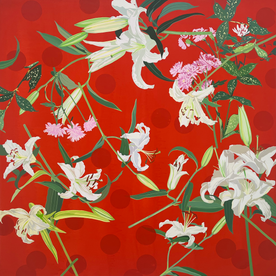
展覽名:no where
當我們醒著時,我們總是在看什麼?眼睛能夠捕捉外界的光並為我們獲取資訊,然而我們的意識卻不一定與眼睛同步線上,有時它已經遊移至遙遠的過去或未來。也許我們都經歷過這樣的時刻:在做白日夢時通過意識感受到某種東西就在我們面前,卻無法用肉眼看到它。長穀川沙織將這種現象稱為“maigo no fuukei”(即“丟失的景觀”)並試著通過繪畫來捕捉生活中意識游離到遠方,終又回歸現實的那些瞬間。對於藝術家來說,將丟失或看不見的風景可視化的想法是矛盾的,但她始終意識到它的存在與通過繪畫探索其本質的可能性。
What are we always looking at while we are awake? The eyes catch the light of the outside world and obtain information for us, yet our consciousness is not always directed at the information that the eye captures, sometimes it has wandered to the distant past or future. Perhaps we've all experienced moments when we feel something right in front of us while daydreaming, but we can't see it with our naked eyes. Saori Hasegawa refers to this phenomenon as "maigo no fuukei" (a lost landscape) Through painting, she tries to capture those specific moments when consciousness wanders away and finally returns to reality. For the artist, there is a contradiction in the idea of visualizing a lost, or invisible landscape, but she is aware of its existence and of the possibility of exploring its essence through painting.
本次展覽中,植物和風景是長穀川創作的主要圖案。她依照觀察繪製植物、通過拍攝儲存的照片再現風景,專注於景觀的每個部分並交疊不同時期的圖案以逐漸構成整體畫面:大片的花葉藤蔓在單色背景前牢牢佔據了視覺中心,又纏繞著擴張到了大橋、江景、海岸、道路等常見的城市景觀中央;明亮的色彩帶來了如沐春風般的視覺愉悅,隨處可見的風景也讓人感到似曾相識。
In this exhibition, plants and landscapes are the main motifs. Plants are drawn by looking at living things while landscapes are drawn from photographs taken and stored, Saori Hasegawa focuses on each part of the landscape and overlaps patterns at different times to gradually compose the overall picture. large-scale patterns of flowers and vines firmly occupy the center of vision in front of a monochrome background, and then quietly climb up into common urban landscapes such as bridges, river views, coastlines, roadways and paths etc. Viewers can feel the pleasure visually at the first glimpse due to vivid colors and experience Deja Vu through those common scenery.
與此同時,長穀川也並未忘記探索思想的來回運動。當藝術家的視線在風景和植物之間來回打轉觀察時,意識便開始了漂移,心靈和意識指向一個無法被稱為任何地方的地方,在記憶和尚未發生的未來時間和空間中徘徊。越過近在咫尺的日常生活與感官,長穀川紗織邀請觀者體驗心靈與身體之間交流的微妙感受,尋找那些不曾看到卻也無處不在的地方。
At the same time, Hasegawa never forget to explore the back-and-forth movement of thoughts and ideas. As the artist looks back and forth between the landscape and the plants, consciousness begins to drift, her mind and consciousness refers to a place that cannot be called anywhere, wandering between memories and future space. Transcending everyday life and senses, Saori Hasegawa invites viewers to experience the subtle sensations and communication between our mind and body, simultaneously seeking out places that are "no where" to be seen but also "no where" to hide.










